Finding agates in California is easier than you think, with colorful stones hiding in deserts, rivers, and coastal cliffs. These gems, formed over millions of years, come in fiery reds, golden yellows, deep blues, and swirling patterns that look like artwork trapped in stone.
Rockhounds from beginners to experts love searching for agates because no two pieces are ever the same. From the rugged beaches of the north coast to the wide-open Mojave Desert, California is packed with spots where you can spot and collect these natural wonders.
Grab your rock hammer and get ready to explore the best places to find agates in California! This guide will walk you through everything you need to spot agates with confidence and actually bring home the good stuff.
The only thing that pairs with it is Rock Chasing’s California Rocks & Minerals Identification Field Guide, which makes it easy to identify what you find so you never walk past something valuable or toss a keeper without realizing it.
What is California Agate?
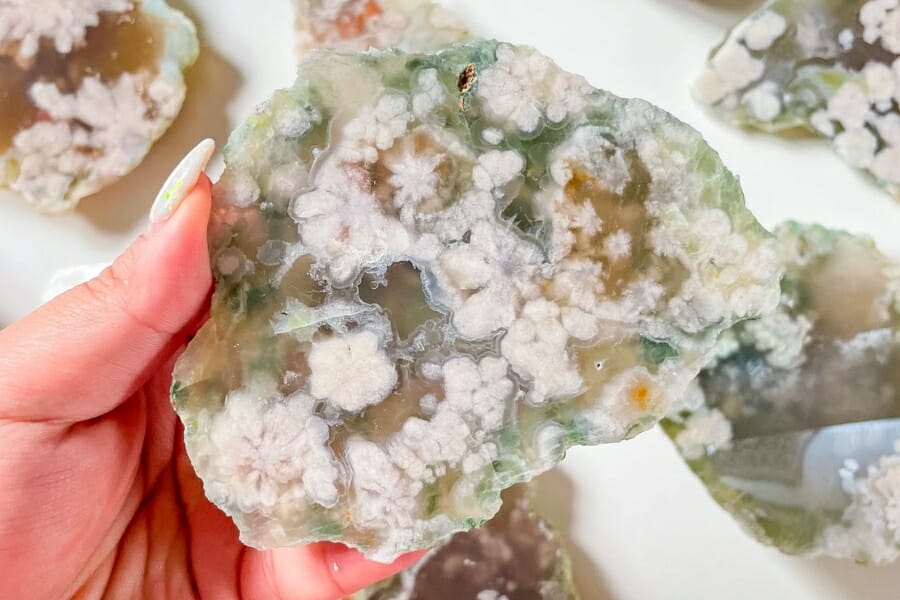
Agate, a semi-precious gemstone, is a variety of microcrystalline quartz called chalcedony. It’s recognized for its characteristic banding patterns. These layers occur in a wide array of colors and are a result of mineral impurities in the silica gel that hardened over time.
Agates form primarily within volcanic rocks or ancient lavas, where they fill the cavities of decomposed minerals. They are typically found in locations where past volcanic activity has occurred or where water bodies have existed, as these conditions support their formation.
Globally, agates are commonly discovered in countries like Mexico, Brazil, India, Australia, and the United States, including California. Its awesome looks and appeal make it a reasonably prized gemstone. If you want to know more about agate’s value and worth, you can read about it in our article.
Blue Lace Agate
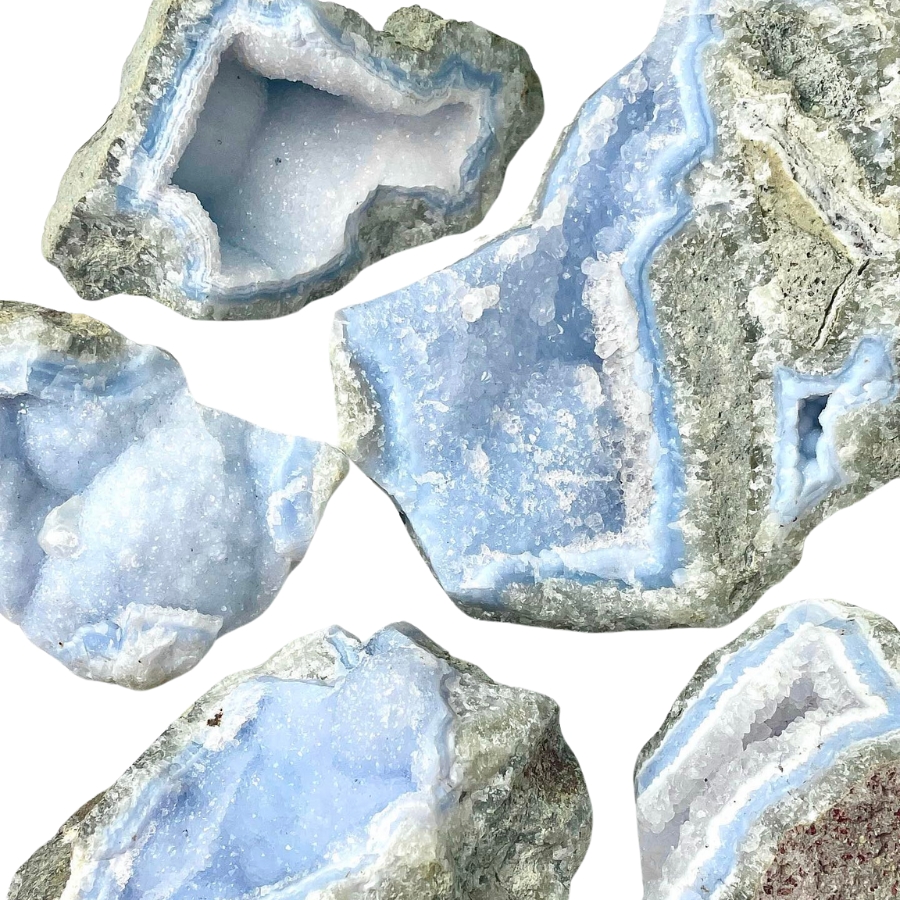
Blue lace agate is like the soft, sky-blue waves with lines that swirl and twist like delicate lace.
Its pattern comes from slow-forming layers of quartz, which create those beautiful, lace-like bands.
The bands of this agate type are often in shades of light blue, white, and sometimes a bit of grey. It’s different from other agates, which usually have more intense colors and stronger patterns.
The value of blue lace agate lies in its soft, tranquil look and the feeling of calm it brings. It’s often used in jewelry or as a decorative stone.
Most people don’t realize how many incredible rocks California hides in its mountains, deserts, and beaches. This guide shows exactly what you’ve been walking past.
🌈 300+ color photos of real California specimens
🪨 Raw + polished examples make identification simple
🏜️ Covers coastlines, gold country, Sierras & more
💦 Waterproof pages built for real outdoor use
Moss Agate
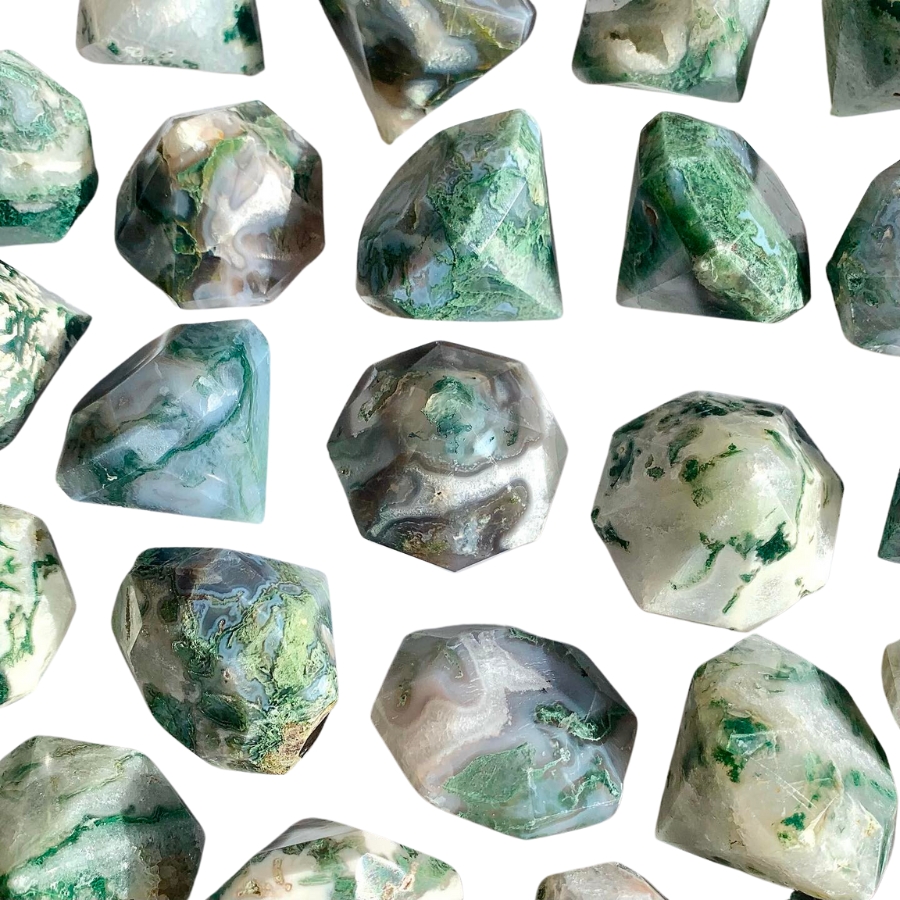
Instead of having the typical banding for which the different types of agates are known, moss agate has green inclusions that look like moss or trees.
These green patterns aren’t real plant material, though. They’re minerals like chlorite or iron oxide.
In some cultures, this type of agate is known as the “gardener’s stone” because of its green, plant-like appearance. It’s believed to help plants grow.
The price of moss agate can vary. It’s often quite affordable, but the more distinct and picturesque the green patterns, the more it might cost.
Fire Agate
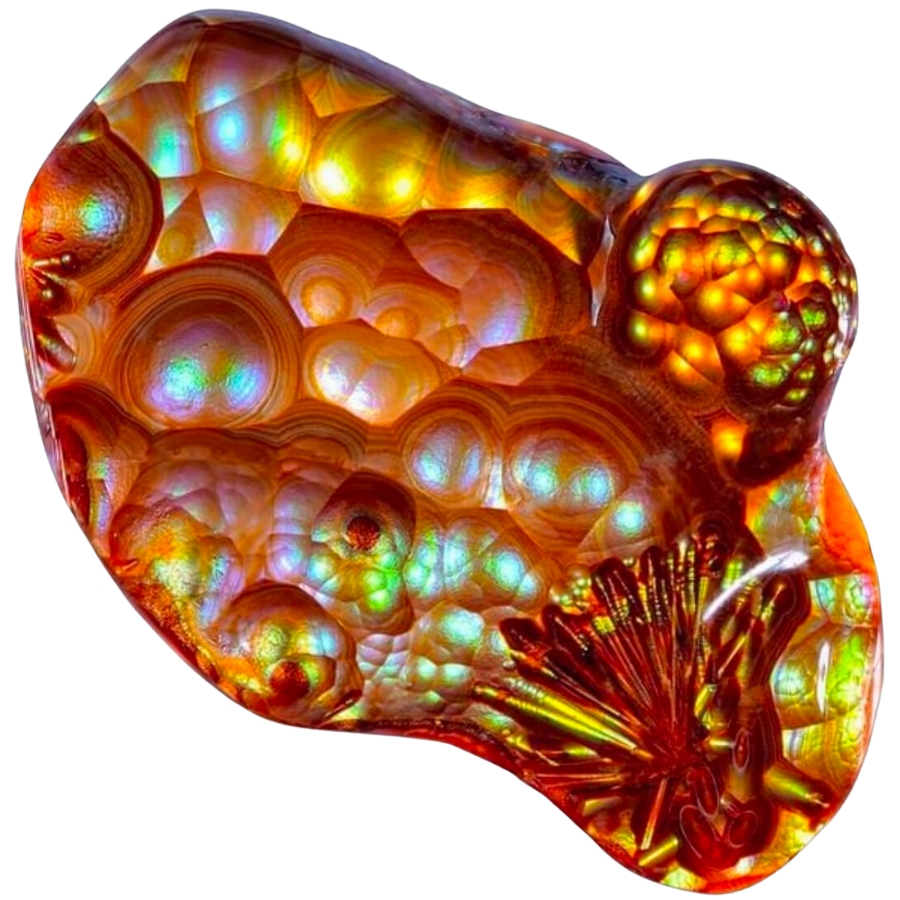
Fire agate is known for its incredible colors and the way it sparkles like fire. It’s got layers of silica and iron oxide that reflect light, creating a fiery effect.
When you look at fire agate, it’s like seeing flames trapped inside. Its colors can range from reds and oranges to greens and golds, all shimmering under the surface.
You might be wondering, “What is fire agate worth?” Well, its value comes from its rare beauty. The more color and sparkle, the more valuable the stone is.
Its fiery iridescence and lively play of color are used in jewelry pieces that are meant to stand out.
Dendritic Agate
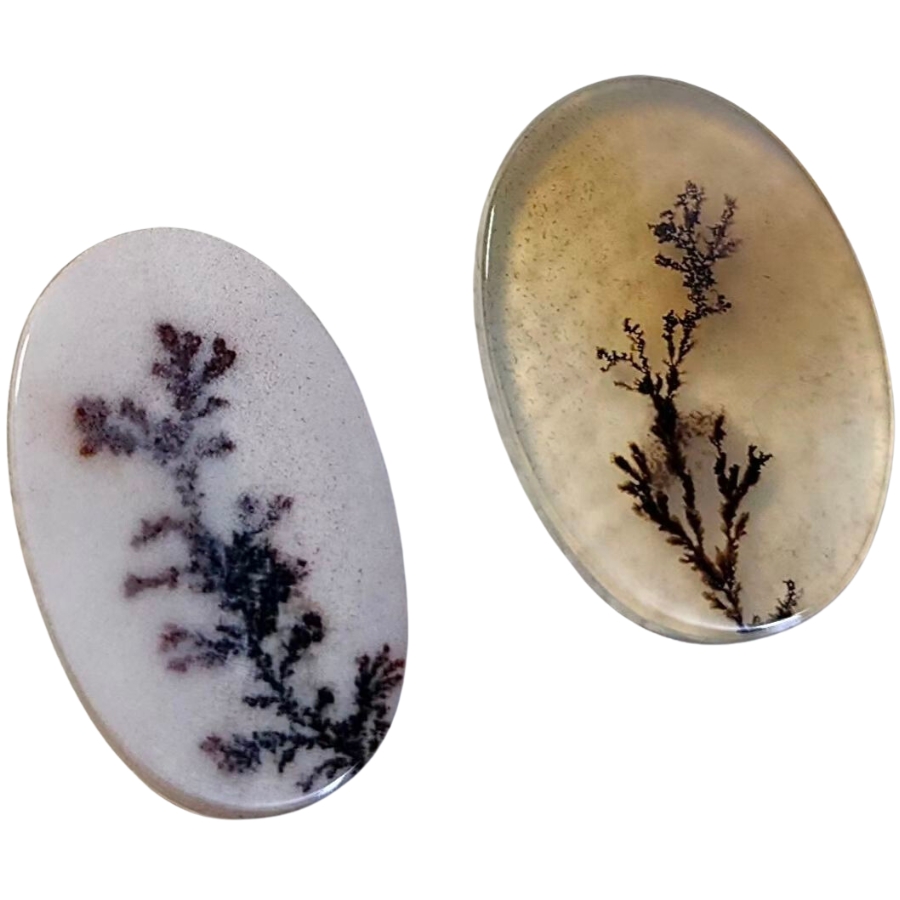
Dendritic agate is known for patterns that look like tiny trees or shrubs. Like moss agate, these patterns aren’t actual plants. They’re made of minerals, mostly manganese or iron oxides.
When you look at a dendritic agate, it’s like peering into a miniature forest or a frosty winter landscape.
The base of the stone is usually translucent to opaque, and the “dendrites”— those tree-like patterns— are often black or brown.
When it comes to how much dendritic agate is worth, it can vary. The more detailed and distinct the patterns are, the more it’s usually valued.
In some cultures, dendritic agate is believed to bring fullness and richness to life.
Crazy Lace Agate
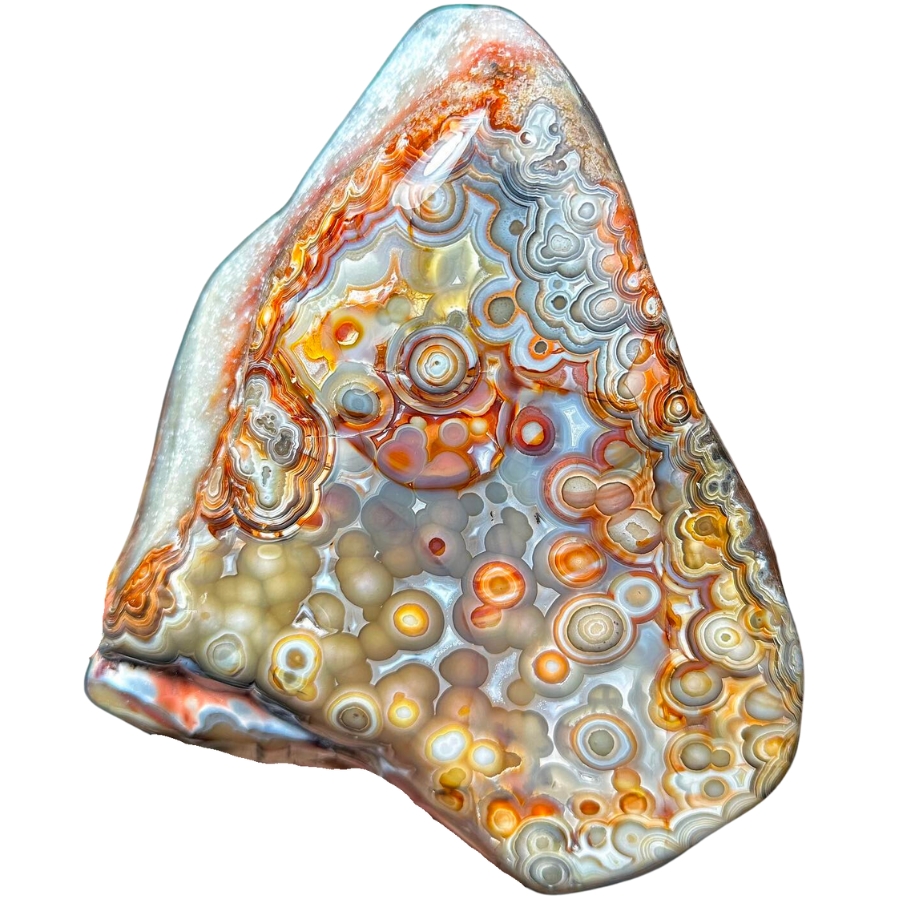
Crazy lace agate is like a party in a rock! It’s got swirls, circles, and all sorts of wild patterns dancing across it.
Its colors can be a mix of red, orange, yellow, and brown, and sometimes even a bit of gray or white.
What makes crazy lace agate stand out is its vibrant and complex patterns. No two pieces are the same. This distinctiveness is a big reason why it’s so valued.
Despite its wild and ‘crazy’ appearance, it’s sometimes called the “Laughter Stone” or “Happy Lace” because of the joy and positive vibes it’s believed to bring.
Laguna Agate

Laguna agate has incredibly sharp and fine banding. It has layers of red, orange, pink, yellow, and sometimes even purple and white all stacked in neat, tight bands.
These bands can form eye-catching patterns, like swirls, loops, and even landscapes.
The different colors of its bands come from various minerals present in the water at the time of its formation.
Laguna agate is considered one of the finest agates in the world due to its exceptional banding. This high regard among agate varieties makes it a prized possession for collectors.
Condor Agate

Condor agate is a real standout. It’s known for its bright, vivid colors and complex patterns.
It has reds, oranges, yellows, and sometimes even blues and greens all swirling together. These colors form in bands or in more random, artistic patterns.
The intensity and variety of its colors is what makes condor agate so special. It’s often used by artists and craftsmen who want to make a statement with their work.
Condor agate’s bold colors and patterns can turn a simple piece of jewelry or art into something really eye-catching.
Fortification Agate (Banded Agate)
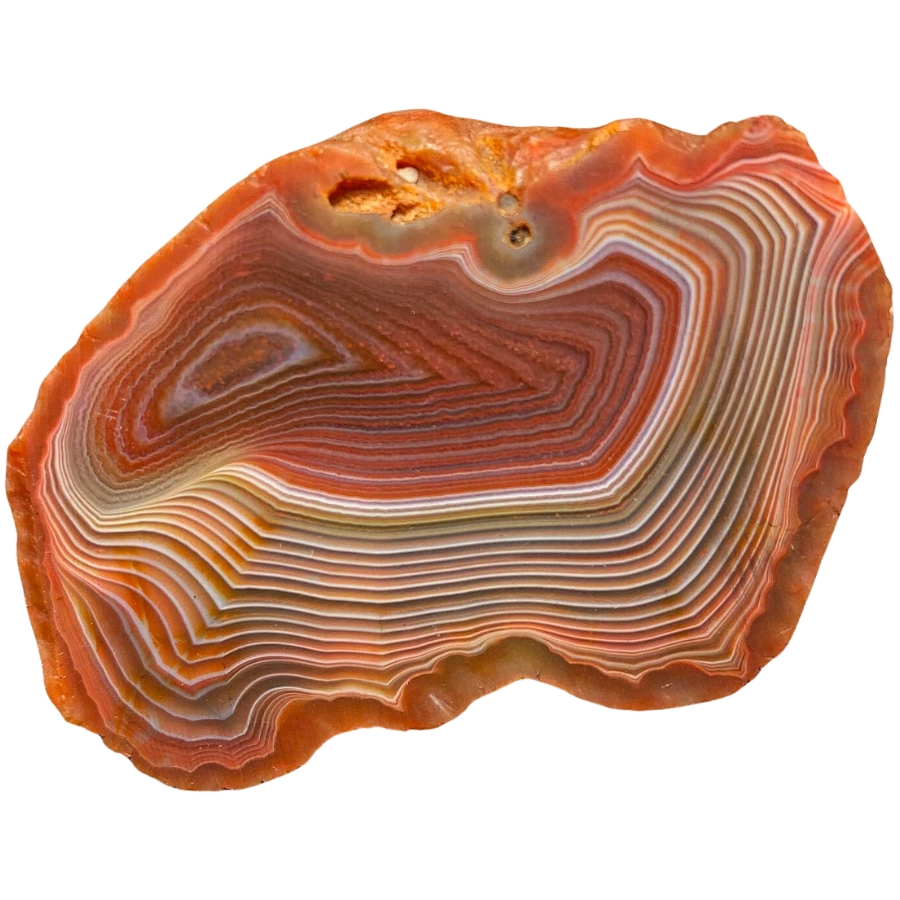
Fortification agate gets its name because the patterns inside it look like the aerial view of a fortified city.
Imagine seeing bands of color forming shapes that look like walls, with sharp angles and curves. They are usually in different colors, making each layer stand out.
If fortification agate is valuable, it’s because of its distinct patterns and colors. Its unique look makes it sought after for jewelry and as a collector’s item.
The clearer and more defined the patterns, the more valuable the stone can be. Some people also believe it can help with relaxation and calmness.
Iris Agate
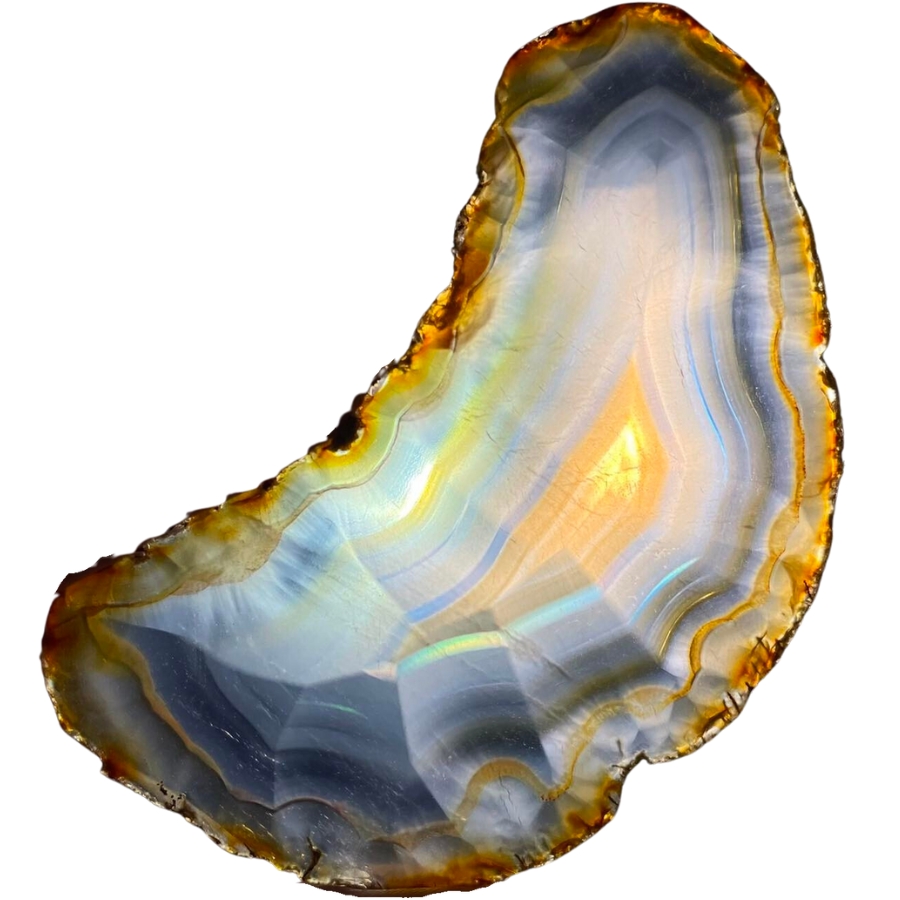
Iris agate looks like a regular agate at first, but when you hold it up to the light, something amazing happens. It shows all these rainbow colors, like light passing through a prism.
This is because it has very thin layers of silica, and when light hits these layers, it splits into all the colors of the rainbow.
The formation of iris agate is similar to other agates, but its layers are super thin, which is what creates the rainbow effect.
The value of iris agate comes from its unique ability to show these colors. In the past, people even used to think it had magical properties because of the way it showed colors. They saw it as a stone of good luck and wonder.
Plume Agate
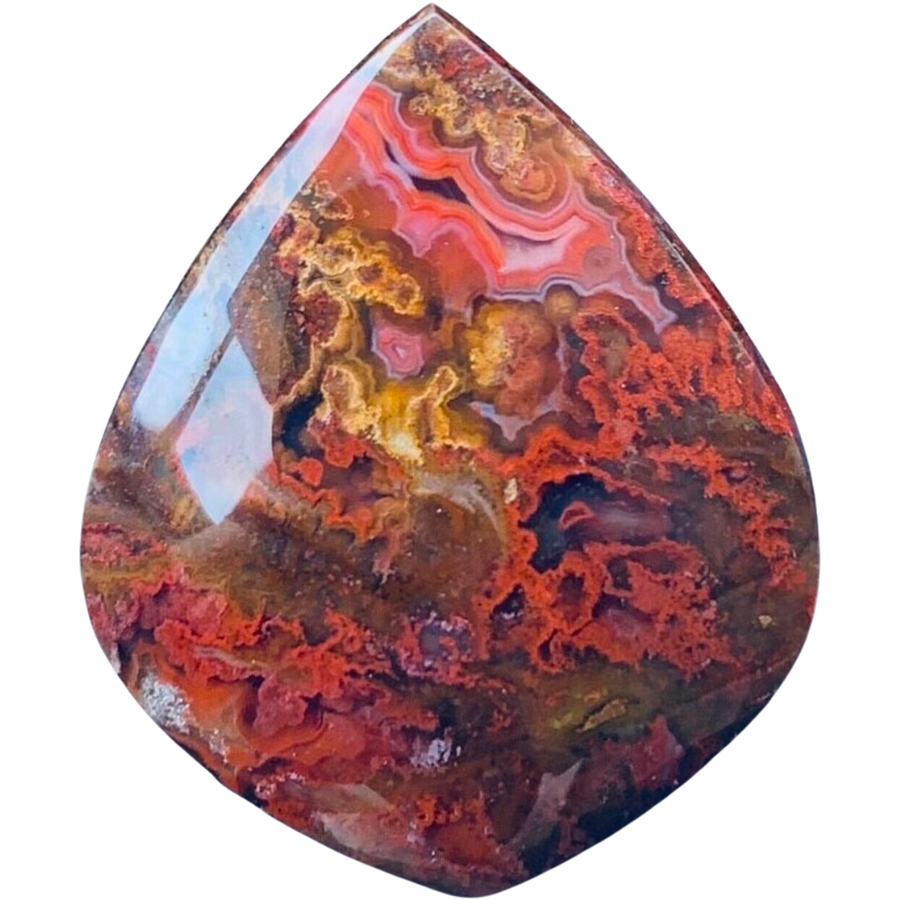
Plume agate gets its name from its patterns that look like soft, feathery plumes. These plumes can be in all sorts of colors: red, black, green, or yellow, set against a translucent or opaque background.
The way these plumes seem to float in the stone makes it look like a frozen underwater scene or like feathers caught in a breeze.
The plumes are made of minerals like manganese or iron oxide, which get trapped in the silica during the agate’s formation and create the feathery patterns.
The price of plume agate can vary depending on how clear and intricate the patterns are. The more detailed and colorful the plumes, the more the stone is usually worth.
Picture Agate (Scenic Agate)
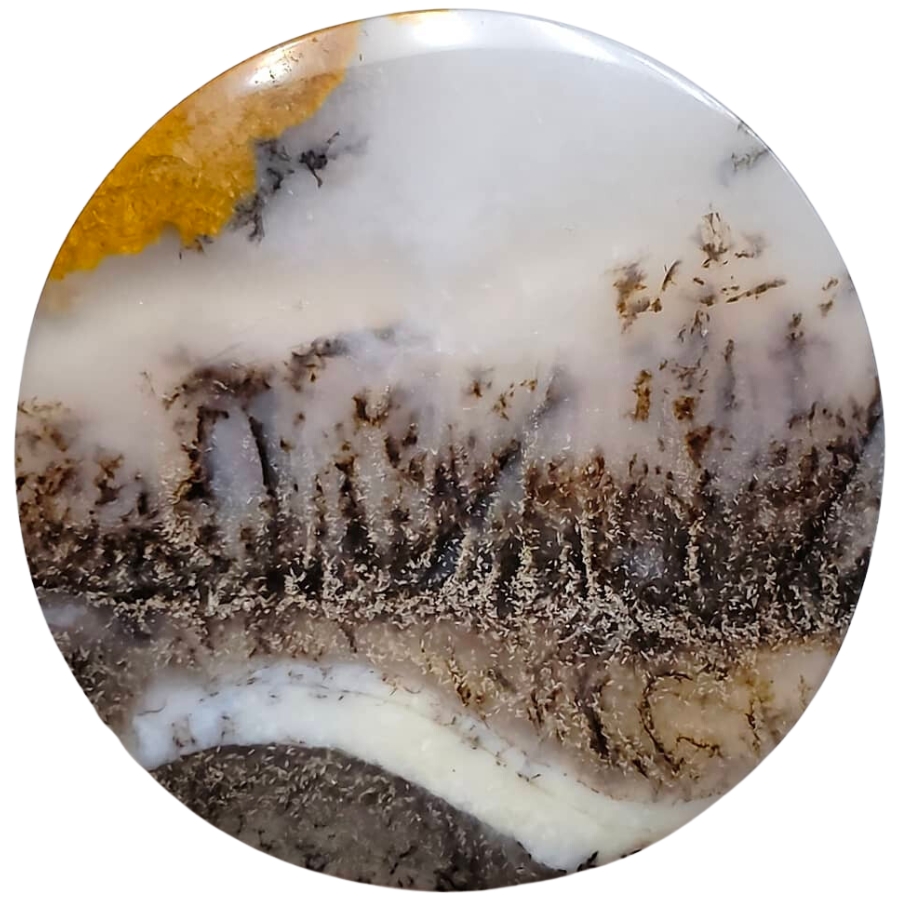
Picture agate is like a snapshot of nature captured in stone because it looks like it has pictures or scenes right inside it.
These “pictures” are actually natural patterns that resemble landscapes, mountains, trees, or even skies. They are usually in different shades of brown, white, and gray against a more translucent background.
The different patterns in picture agate or what’s also called scenic agate are made by various minerals in the water filled with silica that forms it.
If you’re thinking, “What is picture agate worth?“, its value comes from how distinct, clear, and detailed the natural “pictures” are.
Turritella Agate
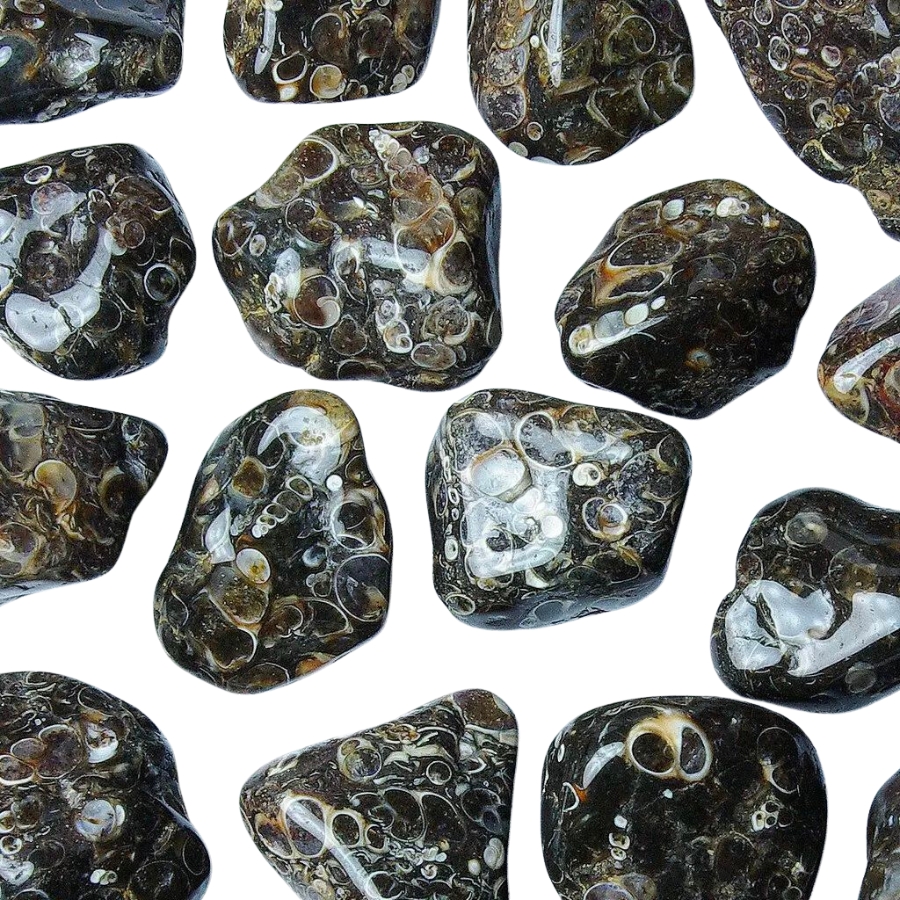
Turritella agate is not your typical agate because it’s full of fossilized snail shells! The shells belong to a creature called Turritella, a type of sea snail.
These shells are tightly packed and create a pattern that looks like a bunch of tiny, swirling towers. The background of the agate is usually a dark, earthy color, which makes the white or cream-colored snail shells really pop.
Over millions of years, these snail shells got buried in sediment and eventually became fossilized. As time went on, silica-rich water flowed through the sediment, turning it into the agate we see today.
The value of turritella agate comes from its unique blend of geology and history. More than a pretty stone, it’s a piece of ancient life preserved in rock.
Fairburn Agate
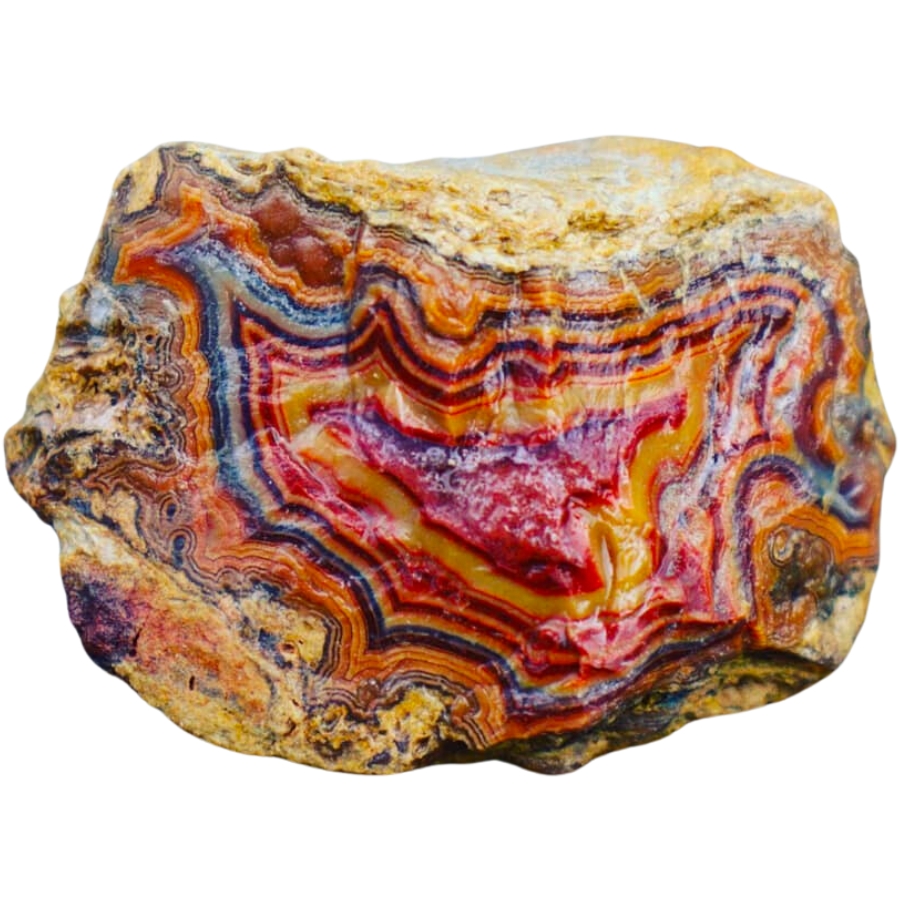
Known for its intricate patterns and bold colors, Fairburn agate is another fascinating type of agate. It usually has bands and swirls of different colors like red, yellow, orange, brown, and sometimes even pink or purple.
What’s special about these patterns is they often look like they’re in layers, creating a 3D effect. It’s like looking at a landscape made of stone.
It’s named after a place called Fairburn in South Dakota. This gives a clue about where it was first discovered.
People value Fairburn agate for the skill it takes to cut and polish it, which makes the patterns and colors really stand out.
Sagenite Agate
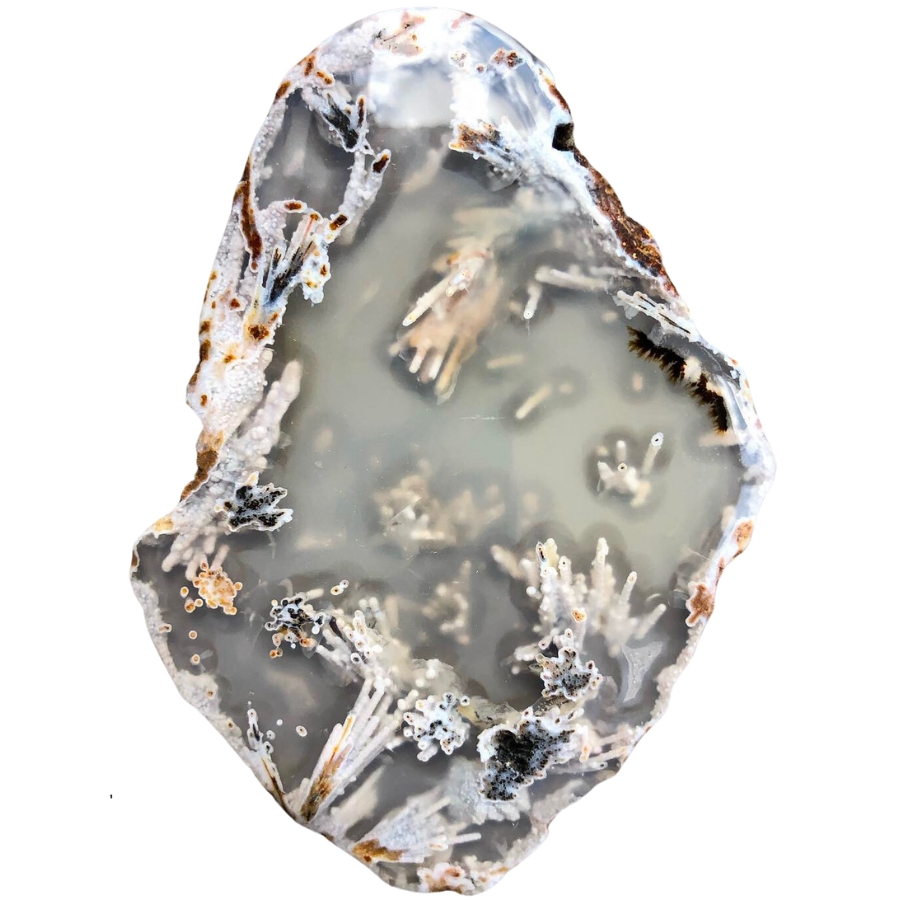
Sagenite agate has needle-like inclusions that look like tiny sprays of crystals inside it. They can be gold, silver, black, or even green, and they spread out in all directions, creating an amazing pattern.
The base of the agate is usually translucent, which lets you see these intricate needle patterns clearly.
These patterns are actually other minerals, like rutile or goethite, that get trapped inside the forming agate. These minerals grow in a crystal shape, looking like needles or hair.
Sagenite agate is often used in jewelry and other decorative items, with some people thinking that its needle patterns look like fireworks or starbursts.
Tree Agate

Tree agate, as its name suggests, looks like it’s got tiny trees or branches inside it. These tree-like patterns are usually green and spread out against a white or light gray background.
The green patterns aren’t actual trees, though. They’re made of minerals like chlorite or manganese.
Each piece of tree agate is different. You won’t find two that are exactly the same. It’s valued for its looks and it’s often used in jewelry and decorations.
Tools You Will Need
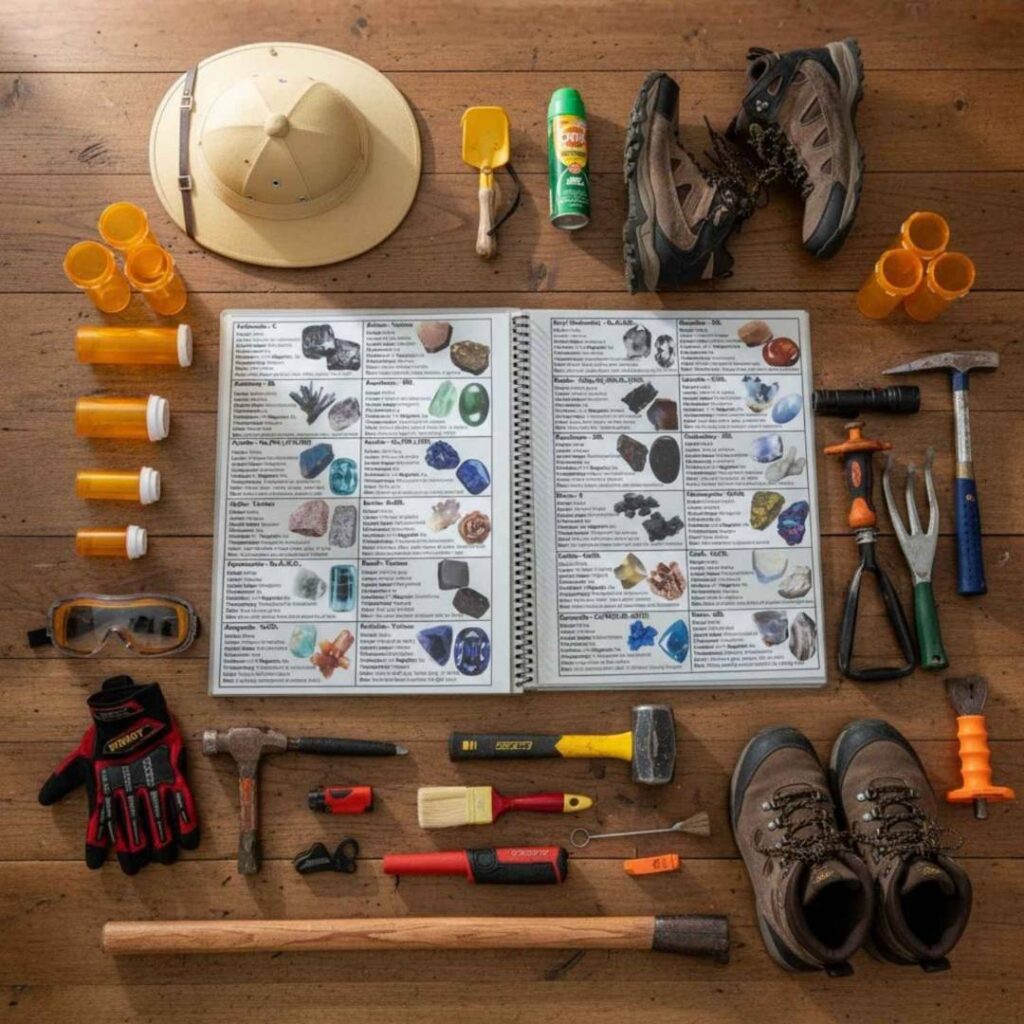
Agates love to hide in plain sight, so having a few simple tools can make your search much easier. Beginners don’t need a big setup or anything fancy. With just a handful of basics, you can explore beaches, riverbeds, and desert washes with confidence and spot good material before someone else does.
A Trusted Field Guide – Essential
A good field guide saves time, cuts down on guesswork, and keeps you from walking past something interesting simply because it didn’t look familiar at first glance.
That is exactly what Rock Chasing’s California Rocks & Minerals Identification Field Guide is designed to do. With more than 120 California rocks and minerals and over 300 clear photos, it turns identification into a quick, practical part of your hunt instead of a slow chore once you get home.
The laminated, waterproof pages hold up to dirt, water, and mud, so you can actually use it in the places where you’re most likely to need it. The simple visuals and quick facts make it easy to check a specimen on the spot.
For beginners, the layout helps you learn geology in a hands-on way that feels approachable. For seasoned collectors, the verified information and detailed images make it a reliable reference for labeling and organizing your finds.
Small Hand Shovel – Essential
A small hand shovel helps you lift rocks, scrape away loose sand, and reach pieces that are half-buried. Agates often sit just under the surface, and a quick scoop can reveal a bright banded stone. This is one of the most useful tools to keep with you because it lets you check spots that your hands alone can’t reach.
Hard-Bristle Brush – Recommended
A hard-bristle brush is perfect for brushing off dirt so you can see the colors and patterns on a stone. Many agates look dull when covered in dust or clay, and a few scrubs can make the details pop. It also helps you clean your hands and tools as you go.
Plastic Bucket – Optional
A simple plastic bucket is lighter than a bag and keeps your finds safe from breaking against each other. It also makes it easier to rinse off stones if you’re near water. While not everyone brings one, it’s handy if you plan to collect a lot during the day.
Pocket Magnifier – Essential
A pocket magnifier helps you check the bands, transparency, and tiny crystal details that set agates apart from regular rocks. It only takes a few seconds to use, but it can be the difference between keeping something special and leaving it behind. It’s small enough to fit anywhere and useful every time you go out.
The key factors in our recommendations are:
- The deep experience and understanding of our team about the area
- Recommendations from local groups and clubs
- How easy it is to get the a particular location
- Safety and potential hazards when collecting
- Weighing private and public locations
- The ability for both experienced and novice agate enthusiasts to find great samples
With these factors in mind we’ve been able to put together a fantastic list that just about anyone can use!
The Best Spots To Find Agates in California
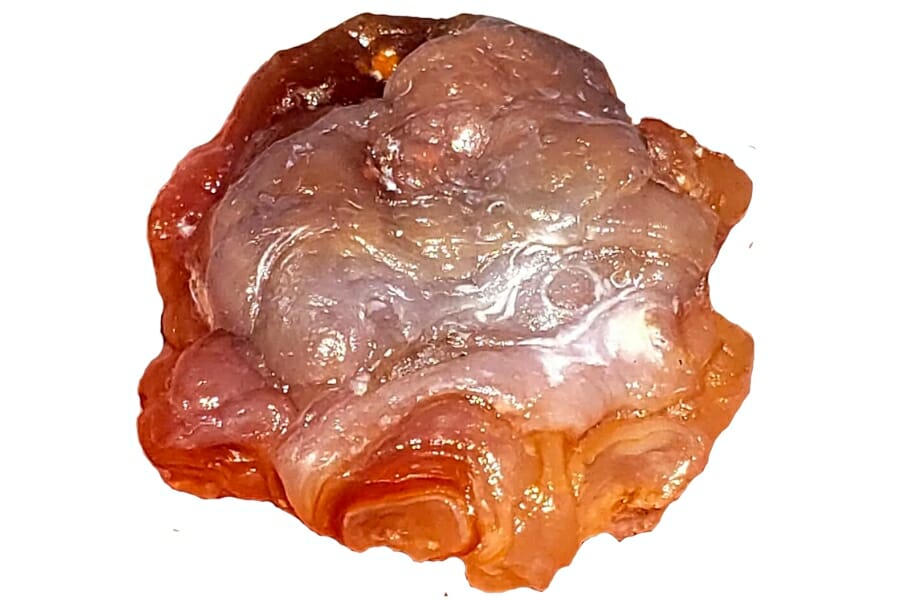
If you aim to find different kinds of gemstones in our state, you can visit our article on the gem mining sites in California. But if you have a laser focus on finding agates, here are our top recommended sites for your visit here:
Always Confirm Access and Collection Rules!
Before heading out to any of the locations on our list you need to confirm access requirements and collection rules for both public and private locations directly with the location. We haven’t personally verified every location and the access requirements and collection rules often change without notice.
Many of the locations we mention will not allow collecting but are still great places for those who love to find beautiful rocks and minerals in the wild without keeping them. We also can’t guarantee you will find anything in these locations since they are constantly changing.
Always get updated information directly from the source ahead of time to ensure responsible rockhounding. If you want even more current options it’s always a good idea to contact local rock and mineral clubs and groups
Kern County
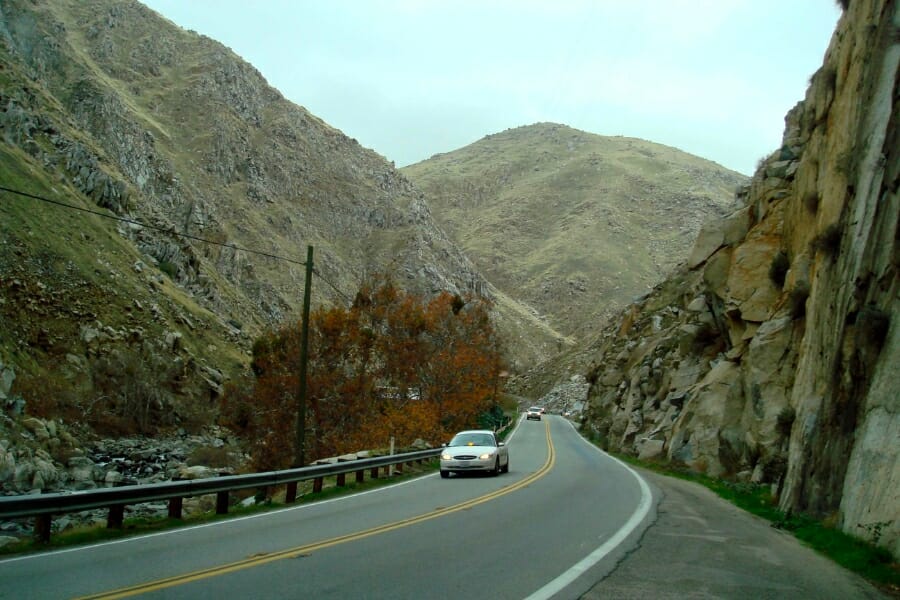
Kern County is a unique part of California that’s full of different kinds of landscapes. Located at the southern tip of the Central Valley, it has a mix of farmlands, deserts, and mountains. To the east, you’ll see the high peaks of the Sierra Nevada mountains, and to the west, there’s the Temblor Range.
Because of its location and mix of landscapes, Kern County hosts many kinds of rocks and minerals— including agates.
Reaching this county is pretty easy. It’s well-connected with major cities like Los Angeles and Fresno by highways and buses. But before you head out, make sure to review California’s most updated collecting guidelines. At the end of the day, we don’t only aim to take home our finds but to ensure sustainable rockhounding.
Where we found agates in Kern County
As home to abundant deposits of different types of agate, Kern County has plenty of specific spots up for your exploration, such as:
- Castle Butte
- Greenhorn Mountain Park
- All surrounding regions in Mojave
- Hills of Brown’s Ranch
- Area surfaces of Red Rock Canyon
- Many prospects in Gem Hill
- Regional surfaces of Wheeler Springs
- Cache Creek Canyon
- El Paso Mountains and the surrounding area
If your kids constantly ask “What’s this rock?”, this guide finally gives you an answer you don’t have to Google later. Quick photos, simple descriptions, and rugged pages make ID’ing rocks fun instead of frustrating.
🔍 Fast visual matching—no geology background needed
💦 Wipe-clean pages made for creeks, beaches & dirt
📚 Simple explanations for beginners of all ages
🌄 Great for California hikes, creek beds & camping trips
Mule Mountains
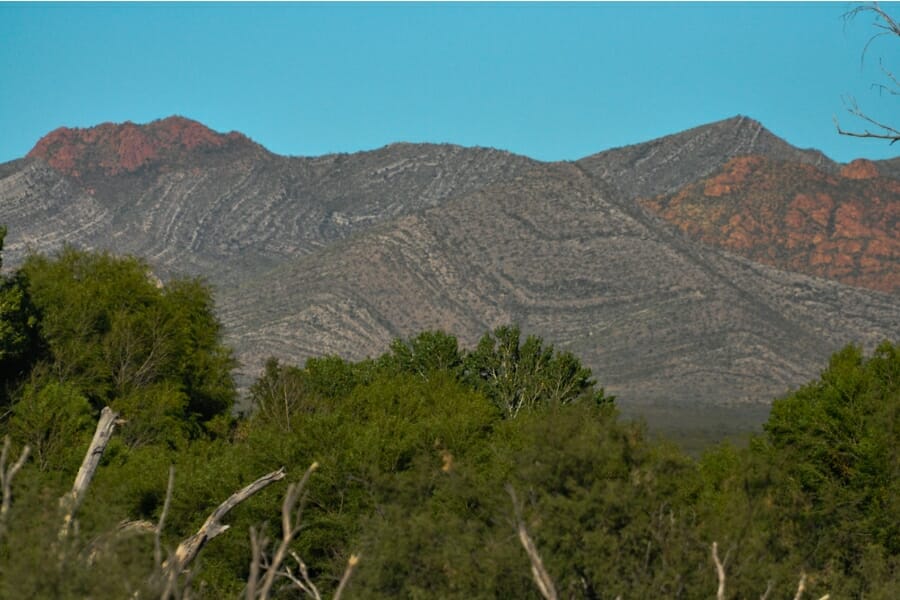
Mule Mountains are part of the Mojave Desert, which means they have a mix of hills, valleys, and lots of desert plants. They’re named after the wild mules that used to roam the area.
What’s really cool about these mountains is what’s underneath their surface. The Mule Mountains have a rich geology with lots of different kinds of rocks and minerals, including your coveted agates.
You can get to this spot by taking a drive from Los Angeles or Las Vegas. It might take a few hours, but the trip is worth it. Once you’re here, the terrain can be a bit rough, so it’s a good idea to have a map and a sturdy pair of shoes.
Where we found agates in Mule Mountains
You can explore the different nooks and crannies of Mule Mountains to find stunning specimens of agate, especially the amusing fire agate.
San Bernardino County
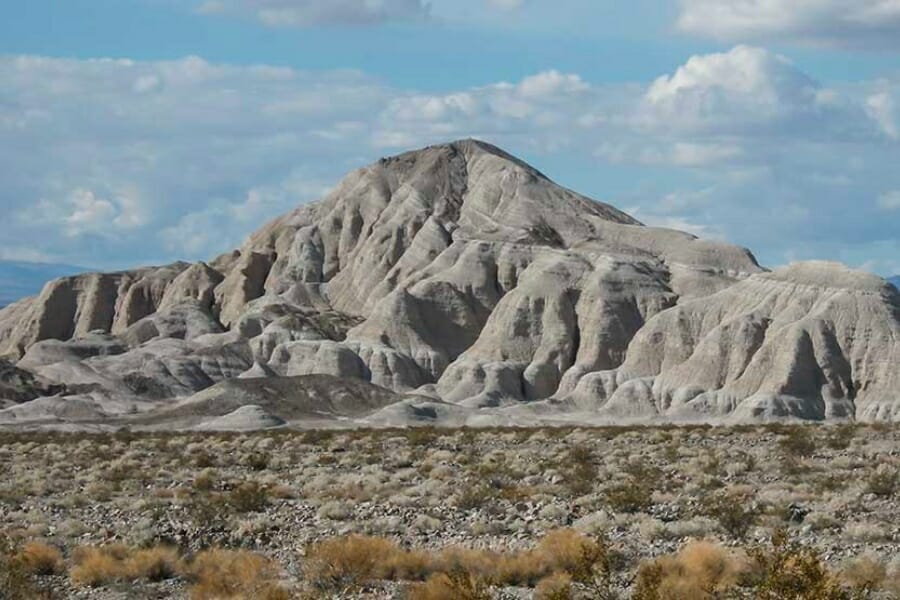
San Bernardino County is full of all sorts of landscapes. It has mountains, valleys, deserts, and even forests! On one side, you’ll see the tall peaks of the San Bernardino Mountains, and on the other, the hot, sandy Mojave Desert.
Once you’re here, you’ll find a mix of city areas and wide-open spaces that are perfect for exploring. These areas, mixed with the county’s different terrains, make it a great place for finding a variety of rocks and minerals, including different types of agate.
If you want to go here, getting to San Bernardino County is a piece of cake. It’s well-connected to major cities like Los Angeles by highways and public transport, so you won’t have any trouble reaching it.
Where we found agates in San Bernardino County
One visit in San Bernardino County will allow you to explore different spots where agates abound, such as the following:
- Kramer Hills along the US 95 area
- Sperry Wash
- Owlhead Mountains
- Eagle Crags
- Leadpipe Springs
- Dirt road in Barstow
- Pisgah Crater
- Lanfair area
- Old mine dumps in Ludlow
- Afton Canyon in Cady Mountains
- Area dry washes, hillsides of Needles
- Wingate Pass area
Tick Canyon
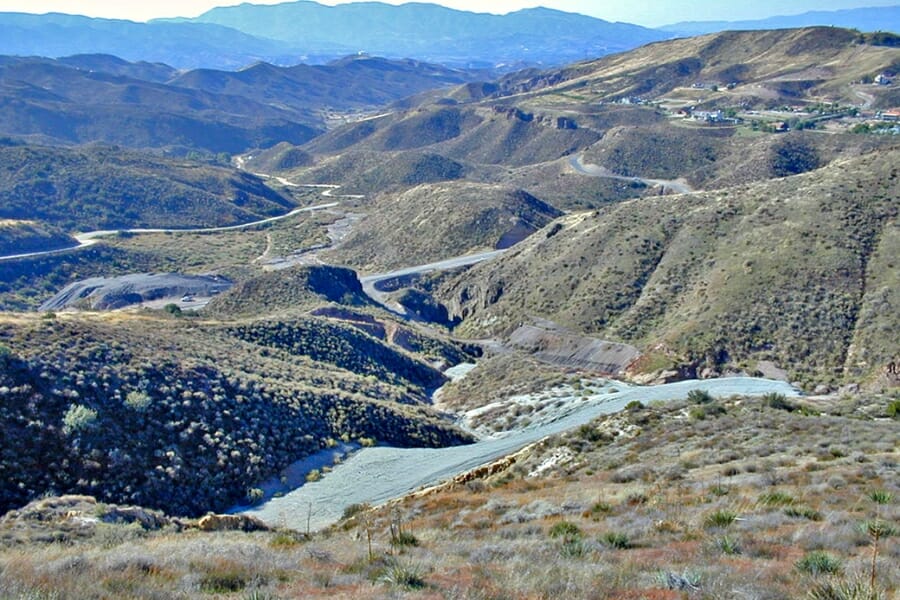
Tick Canyon is an interesting spot in southern California. It’s located in Los Angeles County, near the city of Santa Clarita. As a canyon, it has steep sides and a flat bottom formed by years and years of water erosion. The terrain is rugged and full of scrubby plants, rocks, and dirt paths.
One awesome thing about Tick Canyon is its geology. It’s known for its deposits of agate. It’s also known for the plethora of outdoor activities you can do here, so if you’re into hiking, exploring, and rock hunting, it’s definitely a place to check out.
If you’re going here from Los Angeles, it’s only about an hour’s drive north. The area can be hilly and a bit tough to walk around, so make sure to wear comfortable shoes and bring lots of water.
Where we found agates on Tick Canyon
You can explore the different areas of Tick Canyon, where you can find stunning specimens of banded agate.
Crescent City
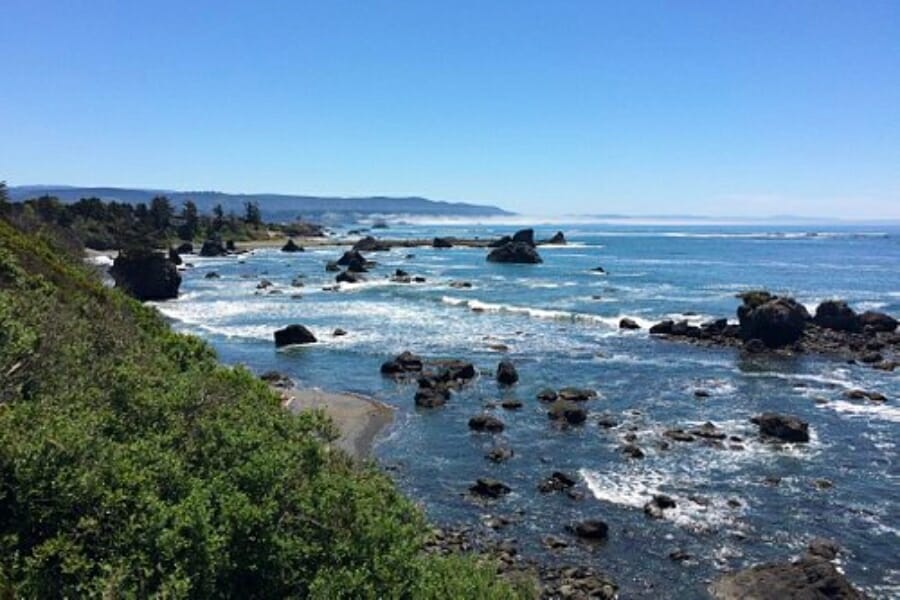
Crescent City is a neat place right along the coast of the Pacific Ocean. It’s named after the crescent-shaped stretch of sandy beach south of the city. Its terrain is really varied— you’ve got the ocean, beautiful beaches, forests, and even mountains not too far away.
The area around Crescent City is really special, not just because of the mix of beaches and forests, but also because of the rocks and minerals you can find. One of those is agate. If you look carefully, especially after a storm, you can find these gemstones right on the beaches around the city.
Getting here takes a bit longer than in other places because it’s tucked up near the top of our state. If you’re coming from San Francisco, it’s about a six-hour drive north. But don’t worry, the journey is full of beautiful sights!
Where we found agates in Crescent City
The beautiful beaches of Crescent City are not only for sightseeing and swimming but for great agate-hunting adventure, too.
Other Great Places To Find Agates in California
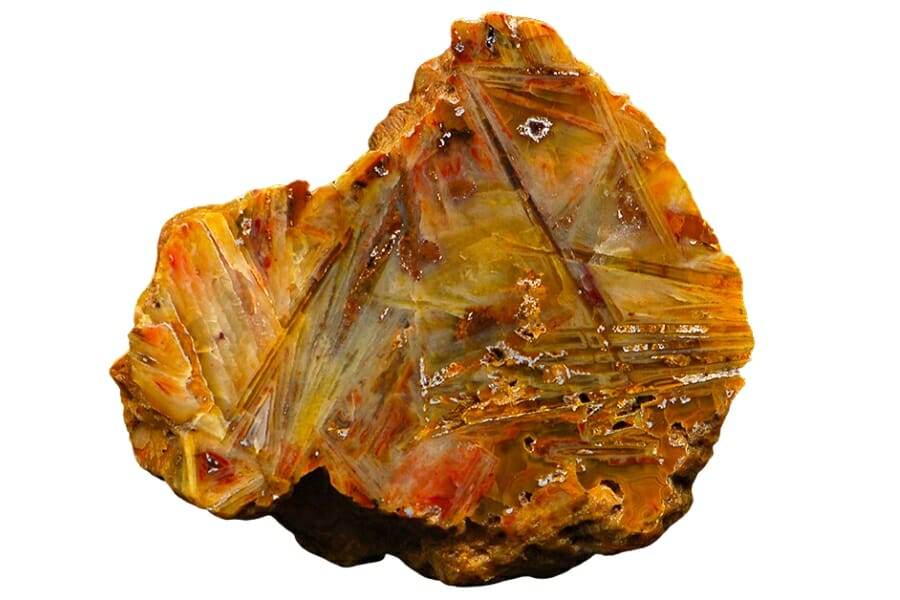
In case you’ve already been to some of our top recommended sites and want to extend your search for agate here, below are more legit spots where you can find them. We’ve arranged these spots by county for your convenient reference.
Our recommendations by county
| County | Location |
| Alameda | Fish Ranch Road |
| Calaveras | Hooten Ranch |
| Calaveras | Marie Costa Ranch |
| Calaveras | Ed Hale Property |
| Contra Costa | Ditch cuts on Skyline Boulevard |
| Fresno | Fresno area gravel pits |
| Fresno | Panoche Pass |
| Humboldt | Beaches in Patrick’s Point State Park |
| Imperial | North on either side of Indian Pass |
| Imperial | Area surfaces of Cargo Muchacho and Chocolate Mountains |
| Imperial | Palo Verde Pass |
| Imperial | Hauser geode beds |
| Inyo | Deadman Pass road |
| Lassen | Stephens Ranch |
| Los Angeles | Hillsides and washes in Action |
| Los Angeles | Sir’Kegian gem beds in Escondido Canyon |
| Los Angeles | Coast Highway in Calabasas |
| Los Angeles | Little Rock Dam and Neary Quarry |
| Los Angeles | Malaga Cove |
| Merced | Mercy Springs |
| Modoc | Fandango Pass between Fort Bidwell and Pine Creek |
| Modoc | Goose Lake |
| Nevada | Pilot Hill |
| Nevada | Sailor Flat |
| Riverside | Gravels west of Blythe |
| Riverside | Railroad tracks and hills of Siam Crossing |
| San Luis Obispo | Area fields east of US 101 |
| San Luis Obispo | Area farms toward the ocean in Nipomo |
| Santa Clara | Guadalupe Mine |
| Siskiyou | Agate Flat |
| Siskiyou | Jenny Creek |
Additional areas you can find agates
We recommend paying extra attention to the following areas where agates usually abound, especially if you’re planning to explore spots that cover wide or broad bases:
Streams and Creeks
Streams and creeks in California are some of the best places to hunt for agates. These gems form deep inside the earth and, over time, water helps to move them downstream. As the streams and creeks flow, they carry along these beautiful rocks, smoothing their edges and sometimes depositing them in gravelly areas.
This is especially true after a big rainstorm. The water churns up the creek beds and uncovers new agates that were buried.
Road Cuts
Road cuts in California are like unexpected treasure troves for rock collectors. When roads are built through hilly or mountainous areas, the construction often cuts through layers of rock. This often reveals hidden gems, like agates.
Since agates are heavier and harder than many other rocks, they can often be found here. What’s even more fun is that road cuts are like ever-changing treasure sites. Erosion from wind and rain can expose new agates over time.
Beaches
Another site you should definitely check out for agate is the beach. Agates are formed deep within the earth and over time, they get carried away by rivers and end up in the sea. Waves then wash these beautiful rocks up onto the beach.
Hunting for agates on the beach after a storm is another thing. The rough waves can uncover new specimens that were hidden in the sand, so you can often find them sparkling in the sunlight after a good rainstorm.
Common Agate-Hunting Questions

In this section, we’ll answer the most common question when it comes to finding agate in California:
Is it illegal to collect agate in California?
It’s legal to collect agate in most areas of California, for as long as you abide by our local collecting guidelines. For starters, make sure you’re familiar with any area-specific rules and regulations in the spot you’ll visit. Also, secure any necessary permit or permission before starting your exploration.
The Best Places To Buy Agates In California

Finding California agate is no easy feat. If you want an easier way of taking home a stunning gemstone, you may visit our trusted local gem stores. Many offer great selections of different rocks and minerals, including various types of agates.
Some of the best one we highly recommend are the following:
- Gems of the West – 41223B Big Bear Blvd, Big Bear Lake, CA 92315
- Geology Rocks! and Minerals – 835 Main St, Chico, CA 95928
- Rock Mama Gallery – 5501 Power Inn Rd #140, Sacramento, CA 95820
- Stories in Stones – 1249 S Main St, Angels Camp, CA 95222
- The Rock Shop – 5115 Quinn Rd, Vacaville, CA 95688
If you have any recommendations for our list please leave a comment below!



